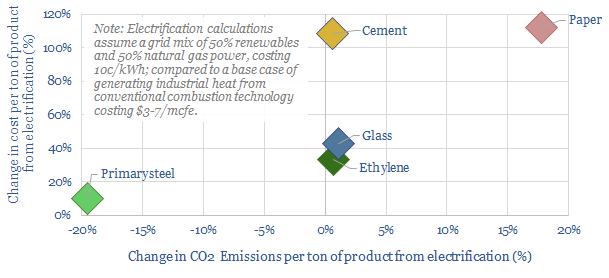“Electrify everything then decarbonize electricity”. This mantra is popular, but dangerously incorrect for industrial heating. It raises output costs by 10-110% without any material CO2 savings. This 19-page note presents five separate case studies in the steel, cement, glass, petrochemical and paper industries, which exceed 15% of global CO2. Only a CO2 price is likely to maximize efficiency gains across multiple disparate industries.
Industrial heating comprises 20% of global CO2 emissions. We outline the market by process, by temperature range and by fuel sources on pages 2-5.
The costs and CO2 intensity of gas, coal and electricity are broken down on pages 5-7, in units of kg/kWh and c/kWh, along with workings. This analysis shows electrification can only save CO2 if it confers a step-change in exergetic efficiency. Which needs to be assessed process-by-process, industry-by-industry.
Electrification of the steel industry is discussed on pages 8-9. Over half of the emissions are chemical emissions from coking. The other half is from blast furnaces. Recycling scrap metal in electric arc furnaces is the best electrification opportunity we can find for any high-grade heating process, but it also has drawbacks.
Electrification of the cement industry is discussed on pages 10-11. Approximately half of the emissions are chemical emissions from calcining CaCO3. Because cement costs are so low, there is a risk that electrification doubles total production cost.
Electrification of the plastics industry is discussed on pages 12-13. Presently there is no commercially available electric alternative to an ethane cracker, although some interesting concepts are at early stages of technical readiness.
Electrification of the glass industry is discussed on page 14. Again, the process is challenging to electrify, and like cement, this can greatly increase production costs.
Electrification of the paper industry is discussed on page 15. Vast quantities of water and steam make this industry one of the least heat-efficient globally. Heat exchangers and heat pumps can help. But they may actually increase CO2 intensity if electricity replaces wood offcuts and other sustainable biomass, currently used as a low carbon fuel.
A comparison of the costs and CO2 intensities of different electrification technologies ties all of our work together on page 16. At best, electrification will have a neutral impact on the CO2 intensity of industrial heat, if renewable penetration ever reaches 50% of the grid. At today’s typical grid mixes, electrification may increase CO2 intensity 20-50%.
Better options are needed to decarbonize industrial heat, as outlined on pages 17-19. No simple mantra like “electrify everything” can substitute for effective process engineering, which is highly site-specific. A CO2 price could incentivize many of these initiatives. We outline attractive options and who benefits.
